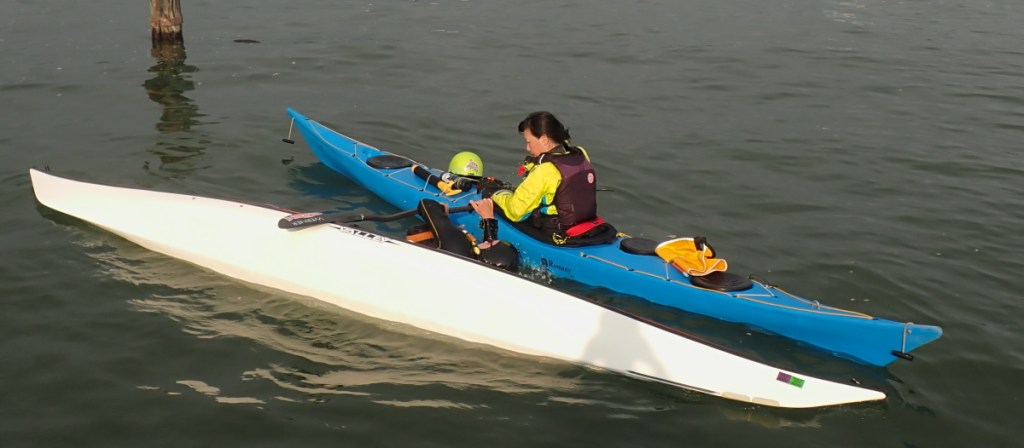Plenty of sea kayakers know the bow rescue – a technique where the rescuer presents the bow of their kayak to a capsizee, so the unfortunately inverted paddler can hip flick back up using the bow for support. There are many Youtube videos showing it, and it’s taught in Paddle Canada and other sea kayaking courses.
A lot fewer kayakers seem to know about the parallel rescue; it’s been a novelty to every fellow instructor I’ve introduced it to. I can’t remember where I first learned it. I certainly didn’t invent it, but it’s been part of my rescue repertoire for decades.
It’s got all the advantages of the bow rescue: the rescuee is back upright in their boat, sprayskirt still attached and cockpit unflooded. Plus, it’s a lot faster to get in position for. In most situations, kayakers are paddling in line with one another, so it takes even the most skilled paddler several seconds to crank their kayak over at a right angle to a capsized boat for a bow rescue. And as any capsizee knows, a few extra seconds can feel like rather a long time when you’re hanging upside down underwater. The faster help arrives, the more likely the topsy-turvy paddler will hang in there rather than punching out.

How’s it done? Dead simple: paddle forwards or backwards as appropriate to put your boat alongside the capsized craft, with a foot or so of space between the kayaks. Lay your paddle across your sprayskirt deck and the hull of the inverted boat. Guide the nearest of the victim’s sweeping hands onto the shaft of your paddle. There’s enough support between the two boats that the rescuee could pull themselves upright one-handed if they want to, but many will choose to bring their offside hand over to the paddleshaft too, so they’re lifting with both arms (and, ideally, a strong knee drive and hip flick as well.)

As with any rescue there are potential hazards. The most obvious is the possibility of a wave from the side slamming the two boats together as the rescuee is rolling up. (Capsizes are most likely to happen when the seas are side on, and an unpropelled kayak – as inverted kayaks tend to be – is likely to broach in any case.) The rescuer should be on the lookout for attacking waves and ready to use their hands to prevent kayak slam dancing, while being careful not to injure themselves.

To me, the risk of boat-to-boat damage seems lower with boats being jostled together side-to-side than with the hammer-and-anvil impact of a bow being torpedoed into another boat’s side.
So how practical is this rescue? A couple of years back I took out a friend who had some training but not yet a lot of kayaking experience. I’d showed her how the parallel rescue worked in the calm lee of a dock, but she still lacked confidence in her ability to perform it for real. So as we took our deep water pleasure paddle in the afternoon I carefully positioned myself slightly ahead and to one side of her boat, then announced I was going over. I heard a gasp from behind me as I capsized, and I did have a bit of a wait until her boat bumped up alongside mine and she remembered how to position her paddle. But in the end, my faith was not misplaced; I did not have to wet exit that day.
